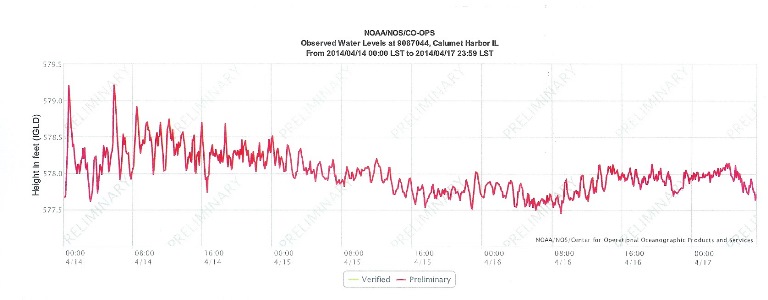It appears 2020 won’t bring relief from high Great Lakes water levels — and they could be even higher than this past record-shattering spring and summer.
Following a generally rainy September, measurements by the U.S. Army Corps of Engineers show every Great Lake, and Lake St. Clair, well above long-term monthly average water levels for October — almost 3 feet higher on connected lakes Michigan and Huron (35 inches) and on Lake St. Clair (33 inches). Lake Erie is 29 inches above long-term October averages, Lake Ontario 20 inches above and Lake Superior 15 inches above.
Forecasters now predict Lakes Michigan and Huron will start 2020 at 11 inches higher than water levels in January 2019, said Keith Kompoltowicz, chief of watershed hydrology at the U.S. Army Corps of Engineers in Detroit.
“The latest forecast extends into March, and for the most part, levels are going to be on-par with or above where they were at the same time last year,” he said
Whether records go even higher next summer will be determined by factors such as snowpack and whether heavier-than-usual rains occur for a fourth straight spring, Kompoltowicz said.
Lake Superior, Lake St. Clair, Lake Erie and Lake Ontario set new record high water levels over the summer, with lakes Michigan and Huron an inch or less off their 100-year highs. In July, lakes Erie and Ontario broke their monthly records by more than 4 inches.
Across the region, that led to flooded campgrounds and streets along Great Lakes connected waterways, caused boating problems with submerged structures, and caused shoreline erosion that all but eradicated some Lake Michigan beaches.
Spooky-high water levels for October
A wet September across Michigan has the Great Lakes and Lake St. Clair well above their long-term average levels for October. It’s potentially helping set the stage for another record-breaking spring and summer of water levels next year.
“Looking across the whole Great Lakes region, that period of January to June this year was extremely wet,” said Lauren Fry, technical lead for Great Lakes hydrology at the Army Corps’ Detroit office, who’s currently serving as a visiting scientist at the National Oceanic and Atmospheric Administration’s Great Lakes Environmental Research Laboratory in Ann Arbor.
“We started to see less precipitation in July and August. But water levels really came up early because of that spring and June precipitation. The lakes take a little while to respond to changes. “The interconnected nature of the lake system also plays a role in region-wide rising water levels, Fry said.
“If the level of Lake Erie is high, that’s going to influence the level of the Detroit River,” she said. “And that’s going to propagate into Lake St Clair, on up into the St. Clair River and eventually Lake Huron.”
The impacts of climate change on Great Lakes water levels going forward isn’t clear. Historical data shows temperatures in the Great Lakes region are rising faster than the rest of the continental U.S., and winter and spring precipitation, particularly via strong storms, is increasing. Those trends are expected to continue. But modeling also shows hotter summers and less ice cover on the Great Lakes in the winter, which will tend to increase evaporation.
Now it all comes down to winter and spring rain and snowfall.
“If we see another winter with a very healthy snowpack, coupled with the flooding rains that we saw last spring, then we would be dealing with even higher record-breaking water levels next year,” Kompoltowicz said.
Even average precipitation levels would keep lake levels well above their historic averages, Fry said.
“It would take a fairly dry season, and even year, to bring things down,” she said.
Keith Matheny Detroit Free Press Oct. 11, 2019

